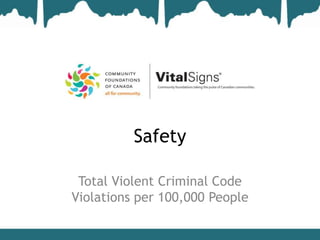
2012 safety
- 1. Safety Total Violent Criminal Code Violations per 100,000 People
- 2. Significance • A safer society has, all else equal, a higher level of well- being. • Violent crimes involve harm or threats of harm to people and a low violent crime rate can significantly improve the lives of a population. • Understanding which communities have low violent crime rates can help people to make informed decisions about where to live.
- 3. Core Indicator • The number of total violent criminal code violations per 100,000 people is used to measure the incidence of violent crime. • In Canada the incidence of violent crime decreased 14.5% from 2000 to 2011, an average of 1.7% per year (see following chart).
- 4. Total Violent Criminal Code Violations Per 100,000 People in Canada 1998-2011 1,550 1,500 1,450 1,400 1,350 1,300 1,250 1,200 1998 1999 2000 2001 2002 2003 2004 2005 2006 2007 2008 2009 2010 2011 Source: Statistics Canada, CANSIM Table 252-0051 (UCR)
- 5. Decline in Violent Crime Rate • The decline seen between 2000 and 2011 can be examined in further detail by looking at specific violations (see following chart). • By far the largest decline occurred in abductions (52%), followed by violent crime with firearms (23%), and robberies (13.4%). • In contrast, forced confinement (kidnapping) increased by 55.6 %.
- 6. Percent Change in Violent Criminal Code Violations per 100,000 people by detailed Violations in Canada, 2000-2011 80.0 60.0 40.0 20.0 0.0 -20.0 -40.0 -60.0 Total abduction Total firearms; use Total violent Criminal Total robbery Homicide Total forcible of, discharge, pointing Code violations confinement or kidnapping Source: Statistics Canada, CANSIM Table 252-0051 (UCR)
- 7. Canada’s Major CMAs • Among Canada’s largest census metropolitan areas (CMAs), only St. John’s, Halifax, and Winnipeg had more violent criminal code violations per 100,000 than the Canadian average in 2011 (see following chart). • Ottawa’s violent crime rate – the lowest among the major CMAs in 2011 – was nearly half the Canadian average.
- 8. Total Violent Criminal Code Violations per 100,000 people in Major CMAs, 2011 1,800 1,600 1,400 1,200 1,000 800 600 400 200 0 Source: Statistics Canada, CANSIM Table 252-0051 (UCR)
- 9. CMA Trends (2000 to 2011) • Between 2000 and 2011, the violent crime rate actually fell in all major CMAs except for Edmonton, Québec, Kitchener, and St. John’s (see following chart). • St. John’s had by far the largest increase in violent crime (26.6%), followed by Kitchener (6.7%). • The violent crime rate shrunk the most in Victoria (down 33.6%), followed by Toronto (down 32.1%).
- 10. Percent Change in Total Violent Criminal Code Violations per 100,000 People in Major CMAs, 2000-2011 30.0 20.0 10.0 0.0 -10.0 -20.0 -30.0 -40.0 Source: Statistics Canada, CANSIM Table 252-0051 (UCR)
